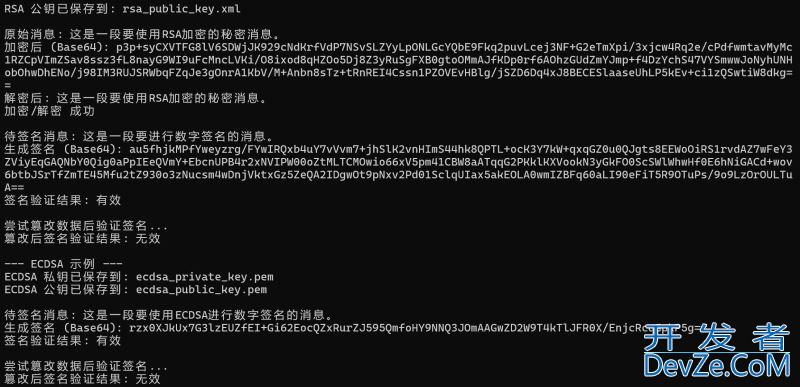C#使用应用RSA和ECC进行数字签名和签名验证的示例详解
目录
- 基本概念
- RSA 算法示例
- 1. 密钥生成与保存
- 2. 加密与解密
- 3. 数字签名与验证
- 椭圆曲线数字签名算法 (ECDSA) 示例
- 1. 密钥生成与保存
- 2. 数字签名与验证
- 主程序示例 (Program.cs)
- 运行环境要求
- 关于数字证书
基本概念
- RSA 通常用于加密少量数据(如对称密钥)和数字签名。直接使用RSA加密大量数据效率较低,更常见的是使用RSA加密一个随机生成的对称密钥,然后用对称密钥加密实际数据。
- 椭圆曲线算法 (ECC) 在相同的安全级别下,密钥长度比RSA短得多,因此在性能和存储方面有优势。它主要用于数字签名 (ECDSA) 和密钥协商 (ECDH),也可以进行加密(通过结合ECDH和对称加密)。
- 密钥保存:在实际应用中,私钥的保存至关重要。通常会使用更安全的方式,如Windows证书存储、硬件安全模块 (HSM) 或加密存储在文件中。这里提供的文件保存示例仅用于演示目的,不应直接用于生产环境。
- 异常处理:为了代码简洁,示例中的异常处理可能不够完善,实际应用中应加强。
RSA 算法示例
RSA算法在.NET中主要通过RSACryptoServiceProvider (旧版) 或 RSA (推荐,跨平台) 类实现。这里我们使用 RSA 类。
1. 密钥生成与保存
using System.Security.Cryptography;
namespace RsaEcdsaCryption
{
public class RsaHelper
{
// 生成RSA密钥对并保存到文件
public static void GenerateAndSave编程RsaKeys(string privateKeyPath, string publicKeyPath)
{
using (RSA rsa = RSA.Create())
{
// 设置密钥长度 (例如,2048位)
rsa.KeySize = 2048;
// 导出私钥 (包含所有参数)
string privateKeyXML = rsa.ToXmlString(true);
File.WriteAllText(privateKeyPath, privateKeyXml);
// 导出公钥 (只包含模数和指数)
string publicKeyXml = rsa.ToXmlString(false);
File.WriteAllText(publicKeyPath, publicKeyXml);
Console.WriteLine($"RSA 私钥已保存到: {privateKeyPath}");
Console.WriteLine($"RSA 公钥已保存到: {publicKeyPath}");
}
}
// 从文件加载RSA私钥
public static RSA LoadRsaPrivateKey(string privateKeyPath)
{
RSA rsa = RSA.Create();
string privateKeyXml = File.ReadAllText(privateKeyPath);
rsa.FromXmlString(privateKeyXml);
return rsa;
}
// 从文件加载RSA公钥
public static RSA LoadRsaPublicKey(string publicKeyPath)
{
RSA rsa = RSA.Create();
string publicKeyXml = File.ReadAllText(publicKeyPath);
rsa.FromXmlString(publicKeyXml);
return rsa;
}
}
}
2. 加密与解密
RSA加密通常是公钥加密,私钥解密。
using System.Security.Cryptography;
using System.Text;
namespace RsaEcdsaCryption
{
public class RsaEncryptionDecryption
{
// 使用RSA公钥加密数据
public static byte[] Encrypt(byte[] data, RSA publicKeyRsa)
{
// OEAP填充模式推荐用于加密,提供更好的安全性
return publicKeyRsa.Encrypt(data, RSAEncryptionPadding.OaepSHA256);
}
// 使用RSA私钥解密数据
public static byte[] Decrypt(byte[] encryptedData, RSA privateKeyRsa)
{
// OEAP填充模式推荐用于解密
return privateKeyRsa.Decrypt(encryptedData, RSAEncryptionPadding.OaepSHA256);
}
public static void RunEncryptionDecryptionExample(RSA publicKey, RSA privateKey)
{
string originalText = "这是一段要使用RSA加密的秘密消息。";
byte[] originalBytes = Encoding.UTF8.GetBytes(originalText);
Console.WriteLine($"\n原始消息: {originalText}");
// 加密
byte[] encryptedBytes = Encrypt(originalBytes, publicKey);
Console.WriteLine($"加密后 (Base64): {Convert.ToBase64String(encryptedBytes)}");
// 解密
byte[] decryptedBytes = Decrypt(encryptedBytes, privateKey);
string decryptedText = Encoding.UTF8.GetString(decryptedBytes);
Console.WriteLine($"解密后: {decryptedText}");
Console.WriteLine($"加密/解密 {(originalText == decryptedText ? "成功" : "失败")}");
}
}
}
3. 数字签名与验证
RSA签名通常使用私钥签名,公钥验证。
using System.Security.Cryptography;
using System.Text;
public class RsaSignature
{
// 使用RSA私钥对数据进行签名
public static byte[] SignData(byte[] data, RSA privateKeyRsa)
{
// 选择哈希算法 (例如,SHA256) 和填充模式 (PSS推荐用于签名)
return privateKeyRsa.SignData(data, HashAlgorithmName.SHA256, RSASignaturePadding.Pss);
}
// 使用RSA公钥验证签名
public static bool VerifySignature(byte[] data, byte[] signature, RSA publicKeyRsa)
{
// 选择哈希算法和填充模式与签名时一致
return publicKeyRsa.VerifyData(data, signature, HashAlgorithmName.SHA256, RSASignaturePadding.Pss);
}
public static void RunSignatureExample(RSA publicKey, RSA privateKey)
{
string messageToSign = "这是一段要进行数字签名的消息。";
byte[] messageBytes = Encoding.UTF8.GetBytes(messageToSign);
Console.WriteLine($"\n待签名消息: {messageToSign}");
// 签名
byte[] signature = SignData(messageBytes, privateKey);
Console.WriteLine($"生成签名 (Base64): {Convert.ToBase64String(signature)}");
// 验证签名
bool isValid = VerifySignature(messageBytes, signature, publicKey);
Console.WriteLine($"签名验证结果: {(isValid ? "有效" : "无效")}");
// 尝试篡改数据后验证签名
Console.WriteLine("\n尝试篡改数据后验证签名...");
byte[] tamperedMessageBytes = Encoding.UTF8.GetBytes("这是一段被篡改的消息。");
bool isTamperedValid = VerifySignature(tamperedMessageBytes, signature, publicKey);
Console.WriteLine($"篡改后签名验证结果: {(isTamperedValid ? "有效" : "无效")}");
}
}
椭圆曲线数字签名算法 (ECDSA) 示例
ECDSA在.NET中主要通过 ECDsa 类实现。
1. 密钥生成与保存
ECDSA密钥通常是公私钥对,公钥可以从私钥派生。
using System.Security.Cryptography;
public class EcdsaHelper
{
// 生成ECDSA密钥对并保存到文件
public static void GenerateAndSaveEcdsaKeys(string privateKeyPath, string publicKeyPath)
{
// 选择一个命名曲线,例如 P-256 (secp256r1)
using (ECDsa ecdsa = ECDsa.Create(ECCurve.NamedCurves.nistP256))
{
// 导出私钥(PKCS#8格式,PEM编码)
string privateKeyPem = ecdsa.ExportPkcs8PrivateKeyPem();
File.WriteAllText(privateKeyPath, privateKeyPem);
// 导出公钥(SubjectPublicKeyInfo格式,PEM编码)
string publicKeyPem = ecdsa.ExportSubjectPublicKeyInfoPem();
File.WriteAllText(publicKeyPath, publicKeyPem);
Console.WriteLine($"ECDSA 私钥已保存到: {privateKeyPath}");
Console.WriteLine($"ECDSA 公钥已保存到: {publicKeyPath}");
}
}
// 从文件加载ECDSA私钥
public static ECDsa LoadEcdsaPrivateKey(string privateKeyPath)
{
android ECDsa ecdsa = ECDsa.Create();
string privateKeyPem = File.ReadAllText(privateKeyPath);
ecdsa.ImportFromPem(privateKeyPem); // 或 ImportPkcs8PrivateKeyPem
return ecdsa;
}
// 从文件加载ECDSA公钥
public static ECDsa LoadEcdsaPublicKey(string publicKeyPath)
{
ECDsa ecdsa = ECDsa.Create();
string publicKeyPem = File.ReadAllText(publicKeyPath);
ecdsa.ImportFromPem(publicKeyPem); // 或 ImportSubjectPublicKeyInfoPem
return ecdsa;
}
}
2. 数字签名与验证
ECDSA主要用于签名,不支持直接的加密/解密操作(需要结合ECDH和对称加密才能实现)。
using System.Security.Cryptography;
using System.Text;
public class EcdsaSignature
{
// 使用ECDSA私钥对数据进行签名
public static byte[] SignData(byte[] data, ECDsa privateKeyEcdsa)
{
// 选择哈希算法 (例如,SHA256)
return privateKeyEcdsa.SignData(data, HashAlgorithmName.SHA256);
}
// 使用ECDSA公钥验证签名
public static bool VerifySignature(byte[] data, byte[] signature, ECDsa publicKeyEcdsa)
{
// 选择哈希算法与签名时一致
return publicKeyEcdsa.VerifyData(data, signature, HashAlgorithmName.SHA256);
}
public static void RunSignatureExample(ECDsa publicKey, ECDsa privateKey)
{
string messageToSign = "这是一段要使用ECDSA进行数字签名的消息。";
byte[] messageBytes = Encoding.UTF8.GetBytes(messageToSign);
Console.WriteLine($"\n待签名消息: {messageToSign}");
// 签名
byte[] signature = SignData(messageBytes, privateKey);
Console.WriteLine($"生成签名 (Base64): {Convert.ToBase64String(signature)}");
// 验证签名
bool isValid = VerifySignature(messageBytes, signature, publicKey);
Console.WriteLine($"签名验证结果: {(isValid ? "有效" : "无效")}");
// 尝试篡改数据后验证签名
Console.WriteLine("\n尝试篡改数据后验证签名...");
byte[] tamperedMessageBytes = Encoding.UTF8.GetBytes("这是一段被篡改的消息。");
bool isTamperedValid = VerifySignature(tamperedMessageBytes, signature, publicKey);
Console.WriteLine($"篡改后签名验证结果: {(isTamperedValid ? "有效" : "无效")}");
}
}
主程序示例 (Program.cs)
将上述类集成到Program.cs中,演示如何使用它们。
using System;
using System.IO;
using System.Security.Cryptography;
public class Program
{
public static void Main(string[] args)
{
// 定义密钥文件路径
string rsaPrivateKeyPath = "rsa_private_key.xml";
string rsaPublicKeyPath = "rsa_public_key.xml";
string ecdsaPrivateKeyPath = "ecdsa_private_key.pem";
string ecdsaPublicKeyPath = "ecdsa_public_key.pem";
Console.WriteLine("--- RSA 示例 ---");
// RSA 密钥生成与保存
RsaHelper.GenerateAndSaveRsaKeys(rsaPrivateKeyPath, rsaPublicKeyPath);
RSA rsaPublicKey = RsaHelper.LoadRsaPublicKey(rsaPublicKeyPath);
RSA rsaPrivateKey = RsaHelper.LoadRsaPrivateKey(rsaPrivateKeyPath);
// RSA 加密与解密
RsaEncryptionDecryption.RunEncryptionDecryptionExample(rsaPublicKey, rsaPrivateKey);
// RSA 数字签名与验证
RsaSignature.RunSignatureExample(rsaPublicKey, rsaPrivateKey);
Console.WriteLine("\n--- ECDSA 示例 ---");
// ECDSA 密钥生成与保存
EcdsaHelper.GenerateAndSaveEcdsaKeys(ecdsaPrivateKeyPath, ecdsaPublicKeyPath);
ECDsa ecdsaPublicKey = EcdsaHelper.LoadEcdsaPublicKey(ecdsaPublicKeyPath);
ECDsa ecdsaPrivateKey = EcdsaHelper.LoadEcdsaPrivateKey(ecdsaPrivateKeyPath);
// ECDSA 数字签名与验证
EcdsaSignature.RunSignatureExample(ecdsaPublicKey, ecdsaPrivateKey);
// 清理生成的密钥文件 (可选)
// File.Delete(rsaPrivateKeyPath);
// File.Delete(rsaPublicKeyPath);
// File.Delete(ecdsaPrivateKeyPath);
// File.Delete(ecdsaPublicKeyPath);
Console.WriteLine("\n所有示例运行完毕。");
Console.ReadKey();
}
}
运行环境要求
- .NET Core 3.1 或更高版本 / .NET 5.0 或更高版本:
RSA.Create(),ECDsa.Create(ECCurve.NamedCurves.nistP256),ExportPkcs8PrivateKeyPem(),ExportSubjectPublicKeyInfoPem(),ImportFromPem()等方法需要较新的.NET版本支持。如果您使用的是较旧的.NET Framework,可能需要调整为RSACryptoServiceProvider和ECDiffieHellmanCng/ECDsaCng,但它们的使用方式有所不同,且通常更推荐使用新的API。
关于数字证书
数字证书是编程公钥基础设施 (PKI) 的核心组成部分,它将公钥与实体的身份绑定在一起,并由可信的第三方(证书颁发机构 C A)进行签名。上述示例只是生成了原始的公钥和私钥文件,并没有涉及证书的生成和使用。
如果需要处理数字证书,C# 提供了 X509Certificate2 类来加载、创建和管理证书。通常涉及:
- 加载证书:从文件 (
.pfx,.cer) 或证书存储区加载。 - 提取公钥:从
X509Certificate2对象中获取RSA或ECDsa公钥。 - 使用私钥:如果证书包含私钥,可以直接用它进行签名或解密。
示例:
// 假设你有一个带有私钥的PFX文件
// string certPath = "myCert.pfx";
// string certPassword = "myPassword";
// using (X509Certificate2 cert = new X509Certificate2(certPath, certPassword))
// {
// // 获取公钥用于验证
// RSA rsaPublicKeyFromCert = cert.GetRSAPublicKey(); // 或 GetECDsaPublicKey()
// // 获取私钥用于签名
// RSA rsaPrivateKeyFromCert = cert.GetRSAPrivateKey(); // 或 GetECDsaPandroidrivateKey()
// // 然后就可以用这些密钥进行签名/验证或加密/解密
// }
程序运行效果如下:

以上就是C#使用应用RSA和ECC进行数字签名和签名验证的示例详解的详细内容,更多关于C# RpythonSA和ECC数字签名和签名验证的资料请关注编程客栈(www.devze.com)其它相关文章!







 加载中,请稍侯......
加载中,请稍侯......
精彩评论